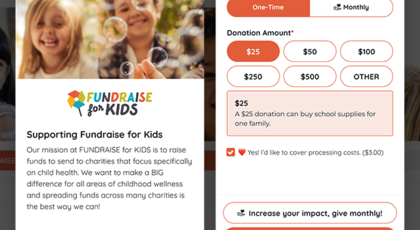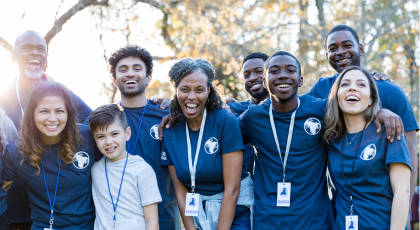
Kay Todd
Product Marketing Manager
Wearable technology is the No. 1 fitness trend for 2022 followed closely by home exercise gyms and outdoor activities. In 2021, Strava saw 1.8 billion activity uploads totaling 20 billion miles from 95 million athletes, making it one of the largest social sports communities in the world.
Fitness has changed, and so has the way we fundraise. DonorDrive fundraisers who use Activity Tracking raise 25% more on average than participants who don’t. Connected, effortless technology is expected, and participants with a seamless experience raise more, engage more, and come back.
We spoke to Cari Speed from CancerFree KIDS to learn how Activity Tracking is changing the fundraising game for their donors, supporters, staff, and corporate partners.
Watch the webinar replay of this Q&A
What is CancerFree KIDS’ mission?
Our mission at CancerFree KIDS is to fund pediatric cancer research. We are based in Cincinnati, so we do a lot of that at Cincinnati Children's Hospital here and then Nationwide Children's Hospital in Columbus, Ohio. We fund really early seed research to try and get new ideas off the ground that can be game-changing for the childhood cancer space. This video goes into some of the impact we've had and the clinical trials that have happened because of us.
Since our inception, CancerFree KIDS has funded 154 novel research projects, resulting in 261 scientific publications, 16 clinical trials, 11 patents, and three startup companies, which have raised an additional $55 million in private investments.
What new trends in fundraising created the most opportunity to build a better participant experience?
- Hybrid events are the new norm.
- New virtual audiences have emerged.
- Participants expect more engaging experiences.
- Corporate sponsorships have evolved.
Coming off of COVID and the pandemic, people are a lot more likely to do things online, or participate in some kind of hybrid event that will be online and in person. People are expecting a different kind of experience than they had in the past. It used to be that you show up for an event, you're there for the day, and that's it. But now, people are used to being online. There's so much more opportunity to engage people over a prolonged period of time, as opposed to that one in-person event.
Then, there are these new people online, and they know they want to do something. They know they want to engage. But they don't know how, and that's our job as nonprofits and fundraisers to figure out what that new opportunity is.
Corporate sponsorships have evolved because people want to get their employees involved. It's not just giving your money to have a logo slapped on something. There's more opportunity now to have your employees be a part of the mission of the organizations you work with. And again, as a nonprofit, that's our job to figure out how we can engage those employees and find ways that we can create an opportunity or experiences where they can get involved as companies.
How did you embrace these new fundraising trends and bring them to life at CancerFree KIDS?
That is where DonorDrive’s Activity Tracking came in. It worked out so well to sync everything together. We created a brand new signature event that uses DonorDrive’s Activity Tracking to pull off a more engaging virtual event.
We also used Activity Tracking to get employees involved from different companies … some that we've worked with before many times. It creates a new package that we can take to a company and say: “This is a new thing we have going on, that we've had engagement with in the past, and we would love for you to try it and get involved with the organization in this way.”
How did you scale your signature fall event in 2021?
We created a new event called the 100 Mile Challenge that we held in September, which is Childhood Cancer Awareness Month. We have always struggled to figure out how to engage people throughout the entire month. We've done a lot on social media in the past, but we never had one event or one really big fundraising campaign surrounding the entire month of September – that's when we started this.
The 100 Mile Challenge is a 30-day fitness and fundraising campaign. We challenged people to complete 100 miles of activity and raise $100 for CancerFree KIDS. 100 miles to me sounded pretty big at first. But people are getting on bikes, and that's a really good way to get your miles in.
Did you do the 100 Mile Challenge?
I did the 100 Mile Challenge! I'm proud to say I really pushed myself. I'm a big walker, but you’ve got to get on the bike to get your extra miles. My dad is a big biker, so I had some quality time with him.
We had participants with young kids, and they did it as a family. The five-and-unders contributed a couple miles, and the parents certainly got their activity in.
What strategies worked so well in 2021 they’re making a comeback in 2022?
A few things we did for that event:
- We created an event toolkit with how-to templates and tips.
- We made email and letter templates for fundraisers.
- We included tips on how to creatively fundraise.
- We shared how to creatively complete the 100 miles, like golf 18 holes.
Weekly emails drove engagement.
The next thing we did through DonorDrive, of course. In addition to Activity Tracking and Achievement Badges, we sent out weekly emails and challenge updates. We would share things about our mission and our participants, whether someone was completing the challenge in honor of someone else, if anyone was fundraising really well, or if a participant was completing a lot of miles, we like to highlight them. I think you get into this mentality: If someone else is doing it, I can certainly do it, too.
Storytelling inspired action and participation.
Going along with that is storytelling. We always want to make sure people share their story on their personal fundraising page, so that everyone and their team members know why they are participating. We would also make sure to include that in our weekly emails, which contain leaderboards, so everyone knows who is logging their activity miles and fundraising the most.
Knowing that other people are doing it makes you go back to your own page, log your miles, and fundraise like they did, or like other people within the community.
Our Facebook Group encouraged community.
The last thing we did that worked really well is the Facebook Group. We created a 100 Mile Challenge Facebook Group that a lot of participants joined. When they register, they get an email that has our event guide in it. Then they get an invite to the Facebook Group. I was really pleased with how many people got on there and said, “Oh, I'm doing something interesting.” An example is one guy who started his 100 Mile Challenge month in a national park.
We had another participant who would donate $1 to herself if anyone texted her in the morning with an encouraging or a get-your-miles-in text. It was cool on our end to see that people were really engaging.
The Facebook Group was open to whoever wanted to be in it, but we saw more engagement from team captains who posted and interacted.
How will you strengthen your fall 2022 strategy with Activity Tracking?
Bring people together for in-person opportunities.
One thing we absolutely want to do is bring in-person initiatives into the campaign. Last year it was completely virtual. We didn't have much in-person interaction. I met a lot of people virtually, and I'm hoping we can get some face-to-face with some of our fundraisers this year. It makes such a difference. We're working with a few fitness clubs in town to host live events. We’re putting time on the calendar to get together on a bike path. We just want to let people know we're grateful for what they’re doing.
Sync activity with automatic tracking.
Within DonorDrive, one thing we’re really excited about is automatic Activity Tracking. Last year, everyone tracked their miles manually, and we had over two-thirds of participants put in their miles, which was really great. We were blown away by the engagement.
But this year with Activity Tracking, they'll be able to sync with Strava and other fitness apps to bring in their activity data automatically. Once they sign up, they can set that sync to go, and it'll run. We're going to see a lot more people keeping up better with their miles, and we’ll see more accurate input.
Launch a corporate competition.
The biggest new initiative in 2022 is the corporate competition. We’re trying to get more employees involved at different companies, whether they're companies we've worked with in the past or companies we're targeting to work with in the future.
We like to think of the 100 Mile Challenge as a fun thing you can do, but the corporate competition has a more competitive nature. Companies are eligible to compete if they have 10 or more people. The company that raises the highest average amount per team member and the company that completes the most average miles per team member will each have a 2022 CancerFree KIDS Research Grant named in their honor, which is a pretty unique prize.
We are mainly targeting companies in the Cincinnati area, because we found that when you reach local companies, it's easier to stay in touch with them and be there for any in-person kickoffs. And those small or mid-sized companies tend to be so passionate if they have a connection to the cause. We did have someone mention blowing it out nationally across their company, which obviously I’m not going to say no to.
Celebrate the end of the challenge.
At the end of the month, we have our Celebration of Champions, which is our traditional dinner and auction event. But new this year, we're having an after party concert. One of the ways we're engaging our 100 Mile Challenge participants with that event is to give free concert tickets to anyone who completes their 100 miles and raises their $100 by September 23. So just another tie-in and way to bring all of our supporters together and transfer them from one event to the next.
How do you follow up with your existing supporters?
That's obviously our biggest group we want to get back for this year — people who did it in our inaugural year. So we're sending all of them personal emails to make sure we give that personal touch. Of course, we're sending out our mass email letting people know this is going on, but we want to make sure those people feel special. We’re saying thank you for doing it last year, we'd love to have you back this year. I'm sure we'll start with phone calls if they don't register right away.
What are your biggest lessons learned or opportunities uncovered?
Start planning and recruiting earlier for more participation.
One is planning and recruiting earlier, which we actually have done this year. Last year, we were going day by day trying to figure out how to get this event off the ground. And this year, we know a little bit more, so we were able to get our DonorDrive site up earlier and start recruiting earlier to get more participation, both from individuals, but especially from those corporations that we are hoping will get involved. You want to target them or talk to them early to make sure they have time to get employees involved and get approval within the company.
With family and friends, we'll see a ton of people register on August 30. That group is easier to sign up and get going. But our corporate competition teams need more ramp up time to get people interested and to know about it in general.
Leverage Triggered Notifications and Scheduled Messages.
We want to make sure we do more Triggered Notifications and Scheduled Messages through DonorDrive this year. This goes along with planning earlier. If we set those up early, then we can focus on making sure the in-person activities are good to go, and we know that our messaging is going off without a hitch.
Share Facebook Fundraiser best practices.
We've seen great success with the Facebook Fundraiser integration with DonorDrive. If people who don’t normally fundraise set up a Facebook Fundraiser, they do better than they ever thought they would.
Overcommunicate everything.
In addition to overcommunicating about the Facebook Fundraiser, overcommunicate everything. We take all of this time to put resources and templates together, and it's all for nothing if our participants don’t use them.
Are you ready to create your own 100 Mile Challenge?
Here are five steps to launching your own activity tracking and fundraising challenge to support your mission:
- Choose campaign timing that makes sense for your goals. CancerFree KIDS chose September to honor Childhood Cancer Awareness Month, but maybe another celebratory month, week, or day makes more sense for your community. Or you could focus on a timeframe when your organization has the bandwidth to engage with your supporters and that won't conflict with existing events and campaigns.
- Make your ask simple but effective and attainable. CancerFree KIDS asks their supporters to raise $100 and track 100 miles of activity. Your ask could be specific to your cause, an anniversary, or another significant number or activity for your organization. Along with miles, DonorDrive campaigns can be set up to track other activity measurements including kilometers, steps, minutes, and reps.
- Create an event toolkit. This is your supporter’s guide to engaging with you, and should be a downloadable document they can access in their fundraising portal as well as included in your communications. Here are a few suggestions for what to include:
- Impact stories, mission information and infographics, and branding guidelines.
- Technical instructions for customizing the participant page, creating Facebook Fundraisers, and logging their activity.
- Creative suggestions for asking for donations or hosting a mini event, and tips for reaching their fitness and fundraising goals.
- Plan your communications. Think about how you will engage current and new supporters in addition to those who have already registered for your event. DonorDrive's Triggered Notifications and Scheduled Messages can help you scale and personalize your communications with emails, text messages, and achievement badges to keep participants engaged throughout your campaign. Also, leverage social media tools like Facebook Group to create more interaction with your supporters. Remember the advice from CancerFree KIDS: Overcommunicate everything!
- Get ready to launch! Make sure you launch your campaign at least a month before your start date, even earlier if your campaign is shorter than CancerFree KIDS’ one month challenge. Many participants will still wait to sign up, but the additional time gives you room to ramp up your communications and gives your supporters time to register, organize their teams, and maximize their fundraising efforts.



